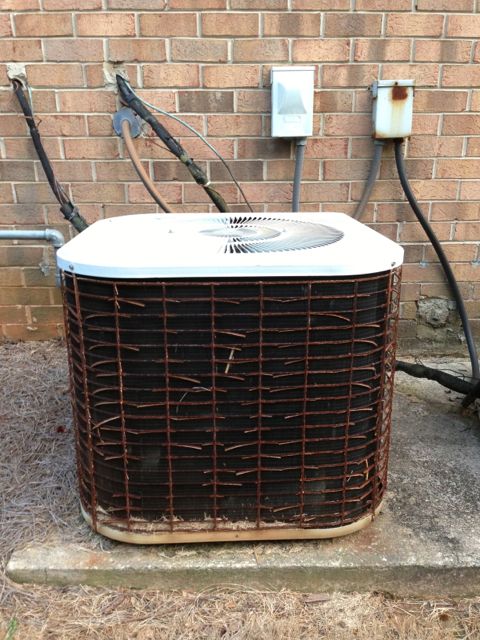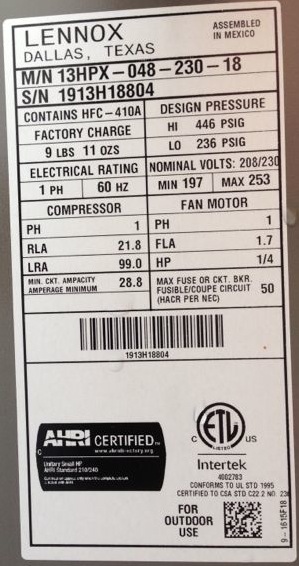How to Determine the Size of Your Central Air Conditioner

Do you know what size your air conditioner is? In the world of building science, you’ll hear a lot of talk about why oversized air conditioners are a bad idea. Why? Briefly, they may not dehumidify as well, short-cycling wears them out quicker, and your home will probably be less comfortable if the air conditioner is too big. But to know if your AC is oversized, first you have to know what size it is. (Note: This article is about finding the size of your existing AC, not determining what size you need.)
Look for the label
The good news is that most HVAC manufacturers make it easy to determine the nominal capacity of your air conditioner. It’s in the model number. Go outside and find the outdoor unit, that metal noisemaker hidden away on the side or the back of the house. It’ll look something like the one you see above, although maybe not quite so decrepit as that one. Then find the lable that gives the data about your AC. It’ll look like the image below.

Up near the top of the label, you see the model number (M/N) and serial number (S/N). The model number is where you can find the number you’re looking for. Not all manufacturers do this, but most will give you a 2 or 3 digit section that tells you how many thousands of BTU/hour your air conditioner can move out of your home.
The first section in the model number gives you info about the type and efficiency of the unit you’re looking at. In the case of this Lennox model (which, by the way, is not from the outdoor unit shown at the top of this article), the 13HPX tells you it’s a heat pump with an efficiency rating of 13 SEER.
The digits you need
Just past that string of 5 characters, though, is the part that tells you the nominal size: 048. That means the air conditioner—or heat pump in cooling mode in this case—has a nominal capacity of 48,000 BTU/hour. I say nominal because the actual capacity is almost certainly going to be different.
The numbers you’ll see on residential air conditioners and heat pumps are:

The 3 digits in the model number tell you the nominal capacity in thousands of BTU/hr. Since each 12,000 BTU/hr is equivalent to 1 ton of air conditioner capacity, it’s easy to figure out how many tons of nominal capacity your AC has.
Pretty simple, eh?
Allison A. Bailes III, PhD is a speaker, writer, building science consultant, and the founder of Energy Vanguard in Decatur, Georgia. He has a doctorate in physics and is the author of a bestselling book on building science. He also writes the Energy Vanguard Blog. For more updates, you can follow Allison on LinkedIn and subscribe to Energy Vanguard’s weekly newsletter and YouTube channel.
Related Articles
Why Is Air Conditioner Capacity Measured in Tons?
3 Reasons Your 3 Ton Air Conditioner Isn’t Really 3 Tons
Why an Oversized Air Conditioner Is a Bad Idea
NOTE: Comments are closed.
This Post Has 11 Comments
Comments are closed.

Prestons will give you good
Prestons will give you good data on units prior to 2005. Worth the cost if you work in the replacement market. I wouldn’t worry as much about replacement windows changing the loads as I would the potential to improve performance by fixing the duct system. Correct sizing, correct construction, and sealing. If you are investing 6-15K for a new HVAC unit – another 1-3K for an effective distribution system is very reasonable. It will do more for comfort than a round of replacement windows that cost more.
Allison – nice topic, which
Allison – nice topic, which as you know leads to others. First the SEER 13 designation. The prefix designation applies to the whole family (series) of air conditioners from a 1.5 ton unit up to a 5 ton unit. In the case of 13 it probably designates the lowest SEER in the group. If it is a higher number however, the (16 to 30) rating probably only applies to the smallest and most efficient unit. The SEER rating applies to specific combinations of the outdoor unit and the indoor unit. See: ahridirectory.org/
As you know SEER is a flawed comparison tool, EER is often better, see http://www.proctoreng.com/dnld/SEER_EER.pdf
Lastly, It is incumbent on us to not blindly assume that putting in a smaller AC will be better. It depends a lot on the ducts and whether the unit is a single speed machine or has more speeds. http://www.proctoreng.com/utilities/sizing.html
I sincerely hope to question
I sincerely hope to question the argument that short AC cycles shorten its life. My system appears set to 3 cycles per hour, controlled by a setting in the thermostat. On hot days, near design conditions, 3 cycles per hour. On mild days (when all systems are oversized), 3 cycles per hour. This is with Honeywell thermostats which are exceedingly common.
I submit you are arguing from what “everybody knows” rather than valid research.
I heartily agree with right sizing equipment and trying to obtain long run times for efficient operation and good humidity removal. Just cannot see that system life is affected.
Thank you for publishing this series and considering this matter.
+! what Proctor said. Nominal
+! what Proctor said. Nominal SEER ratings can be very misleading.
@M.Johnson, cycle settings affect the minimum run-time at part-load conditions. They have little to no affect if AC needs to run longer than the minimum to satisfy the set-point.
Selecting a longer minimum run-time (fewer cycles per hour) trades off against tighter temperature control when load is significantly less than capacity. However, if AC is properly sized, a good thermostat should be able to maintain the local temp well within 1 degree F under all load conditions. How well it can maintain perimeter temps depends on house and duct system.
The cycles per hour matter: I
The cycles per hour matter: I still think this probably has no measurable effect on system life. To say short cycling “wears equipment out quicker” is a perfectly good hypothesis, but a hypothesis needs some kind of experiment to report that as truth.
Another perfectly good hypothesis is “longer run times wear it out quicker”, which at least has some intuition in its favor. I have heard mediocre building advice guys say this. I do not believe that either, but present it as a contrast to the other hypothesis.
My hypothesis: length of cycles has no measurable effect on system life. The equipment is made to do this, so well engineered, that equipment fails for some other reason than simply wearing out.
With the number of design days being far outweighed by the number of cooler days, I think we must accept that short-ish cycles are a fact of life we cannot escape. I really think the equipment is fine with that. Based on my most recent AC install, one can get pretty good humidity removal with 3 not-so-long cycles per hour.
My York heat pump is fifteen
My York heat pump is fifteen years old and its 4 ton for 1665 sq ft and it cycles on and off every 6 or 7 minutes.I haven’t had any problems with it at all but will get 3 1/2 ton next install so my rh drops from 60 to 50.home stays cool but it comes on and off 8 times per hr.and I know this is too much.if I go with 410a unit could I keep line set with smaller unit too if I get them cleaned and flushed.
Bob, If the RH is too high,
Bob, If the RH is too high, where is it coming from? Are your showers, bath tubs and the kitchen equipped with ventilation fans to the outside? Does everyone use them? or are they noisy and don’t get used. Do they move enough air when they are on. Buy a 50 CFM fan (to meet code) and hook it up to 6 feet of duct work, you get maybe 40 CFM perhaps less.
I differ from M. Johnson’s
I differ from M. Johnson’s view that increased cycle rate does not reduce system life. While I have no hard and fast data as he would like to base his perspective upon, I do have much field experience, and observations I’ve made while working on residential and commercial HVAC systems.
Let’s take out a magnifying glass and examine what happens to a residential split system when it first starts up. During the off cycle, oil in the compressor tends to drain off bearing and other close contact areas and collect in the compressor’s sump. When the compressor starts, for a brief moment all of these surfaces have insufficient lubrication until an oil film reestablishes on these surfaces. Not much consequence, of course, because this interval is quite short. However over time, the extent of which this short interval contributes to any long term wear and tear depends on how often it occurs.
Next, the compressor, if it is a PSC motor, and the blower and condenser motors, if they are also PSC, undergo “inrush current” every time they start. Sure, the windings can handle this. The contact points on the contactor can also handle it. But, regarding the latter, a penalty known as an “arc” is assessed each time those contact points make and break. The more often that happens, the quicker the points will become pitted, fouled, and eventually useless.
There is also strain on each of these motors as they instantly attempt to reach rated speed.
Now, let’s look at the oversized aspect Allison discussed in his blog entry above; how that comes into play concerning what I just discussed should be obvious, if it is true that oversized systems tend to short cycle.
Yes, a well maintained, oversized system can run for years and not encounter major failures. It could also fail sooner than it should for the same reason. The extent of each possibility would require extensive data collection, which I don’t see anyone being all that motivated to do. That said, the aspect of physics and entropy lean my view toward short cycling favoring a reduction of expected system life vs. no difference to prolonging it.
I want to know about my
I want to know about my central package unit ac ……how much tons is it ……details company lennox , model :-tca150s2bnm,lra-75 …Please tell me this machine is of how much tons
i ben getting estimates on my
i ben getting estimates on my home also. i have 1000 floor square feet. i have hade 2 estimates both said 2.5 ton with number of my vents, judging by my size. i would say u are in range at needing a 3.5 ton i know the guys giving me estimates also both asked what temp i desired on a 100 degree day, cause u can go alittle smaller but it might only pull it down to 76-77 degress on a hot hot day. u dont want that u want to be able to get 70-72 degrees if wanted.but i am no expert just tellin what i was told by them the hvac guys.
Bradley — the "
Bradley — the “necessary” size for your air conditioner depends on what climate you live in, the insulation, air leakage, and windows of your house. The question cannot be answered by the square footage of the house or the number of vents.
Find a new contractor who will talk about insulation, windows, etc. rather than the vents and square footage.
All that said unless you live in a very hot place, with a very leaky house, with little or no insulation, with single pane windows, then 2.5 or 3.5 tons will be too big.